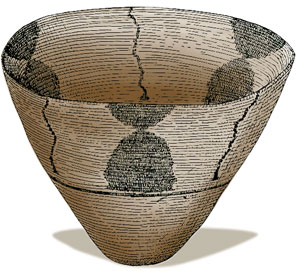Peoples of the Mesa Verde Region
Basketmaker II: 500 B.C. to A.D. 500Artifacts

A Basketmaker II basket. As the name of this period suggests, people during the Basketmaker II period made exceptionally high quality baskets. Baskets were finely woven and, when lined with pine pitch, would have been watertight. Baskets were used not only for storing and transporting food and water but for cooking as well. People would heat stones in a fire and then drop the stones into a basket containing food and cooking liquid. The hot stones would heat the liquid sufficiently to cook the food, without burning the basket itself. 
Sandals made of plant fibers. Other woven materials sometimes found at Basketmaker II sites include aprons, bags, sandals, and tumplines. A tumpline is a strap worn across the chest or forehead that supports a basket or other load on a person's back.

Trough metates and two-hand manos were used to grind dried corn and other foodstuffs. With corn now a staple in their diets, the people of the Basketmaker II period began using a new style of mano and metate. Two-hand manos were rectangular or oblong rocks large enough to be held in both hands. Trough metates had a rectangular depression, or trough, that was open on one end, allowing the ground corn to spill into a container. Other grinding tools used during this time include pestles, one-hand manos, and basin metates. Hunters during the Basketmaker II period still used atlatls and spears to kill their prey, but they developed new styles of projectile points. There is some evidence to suggest that the bow and arrow was introduced late in the Basketmaker II period, but this new weaponry didn't replace the atlatl and spear until the next period. 
Awl made from a turkey leg bone. Domesticated turkeys were introduced to the Pueblo Southwest about 200 B.C., possibly from areas to the east. Interestingly, there is little evidence that the birds were eaten. Rather, they appear to have been raised for their feathers and bones. Feathers were used to make blankets; bones were made into a variety of items, including awls used in the manufacture of baskets. 
Stone pendant and beads on fiber cord. People also made ornaments (for example, pendants and other jewelry) and special-purpose items out of various materials. Stone pipes found at some sites might have been used in ceremonies or rituals. Some objects were made of shell that came from distant coastlines. The presence of such items at archaeological sites suggests that Pueblo people during Basketmaker II times had contact with peoples beyond the Mesa Verde region. Late in the Basketmaker II period, people began making pottery—a crude, multipurpose brown ware. But not until the manufacture of true cooking vessels in the following period did pottery become standard household equipment. |
|
Acknowledgments | Illustration credits | To borrow, cite, or request permission | Please take our survey! Title page for Peoples of the Mesa Verde Region |
|
 DONATE TODAY
DONATE TODAY
